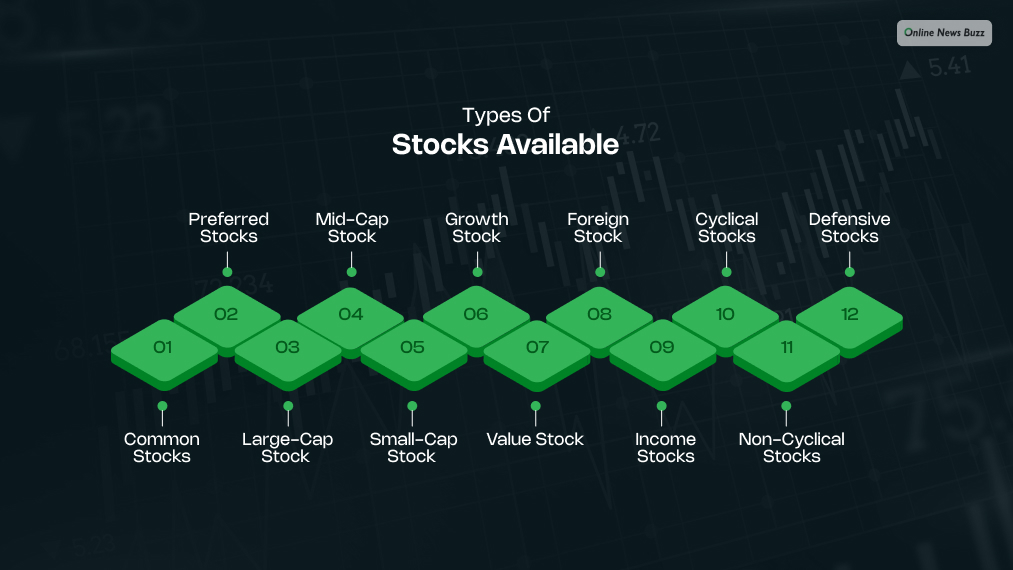
When people think of stocks, they mostly think of the publicly listed shares which are traded on the stock exchange. However, when a new investor is beginning to think of investing in the stock market, it is important to know about the different types of stocks that are available in the market.
Before going deep into investing, the investor should know about the unique characteristics of different types of stocks and then decide which is suitable for investing. So, let’s get on with the different types of stocks and what income opportunities they bring.
Types of stocks available

The stock market is a scary place for new investors. It is difficult to understand where to begin with the financial jargon and the market volatility. However, it is not as difficult as it seems. So, let’s have a simplified look at the different types of stocks that are available in the market.
As an investor, you need to have the basic concept and need to know about the different categories to make a sound decision. It can be classified depending on different parameters like market capitalization, class, dividend payout, class, etc.
Stocks based on market capitalization
Below, we have the different types of stocks available in the market, trying to take the confusion that you might have as a beginner in this field.
Common stocks
Common stocks that pop up in your mind the moment you think of investing in stocks. These provide you with an ownership stake in the business and also the ability to vote on important matters like adopting different company policies and the board of directors.
Whenever the word stock comes up, people think of charts and prices that keep on changing all throughout the day. However, when you buy stock, you actually purchase a stake in a business.
The long-term returns are driven by the earnings and the overall success of the company in which you have invested. Earnings and growth contribute to the higher share price for owners of common stock and allow the company to share the earnings with shareholders in dividends. If you are looking for the “best stocks to buy now,” this can be your choice.
Preferred stocks

Preferred stock is more of a bond than a stock. Also, you will not have any voting rights, but you will get dividend payments before common stakeholders get them. Preferred stocks are issued at par value, and you get to redeem the shares when they mature.
Here, you don’t have the price appreciation option that you have with common shares. The returns will mainly come from the dividends that you receive. These stocks can sometimes be redeemed before maturity, and some preferred shares can also be converted into common shares.
The opportunity to gain significantly from preferred stocks is much less than common stocks. However, the risk here is also considerably lower than common stocks.
Large-cap stock
The world of common stocks is huge. So, it is better to divide it by separating companies depending on their market capitalization or the complete value of the outstanding shares. Well, there is no exact definition of large-cap stocks. These are mainly those companies that have a market cap of around $10 billion or more.
These are typically established companies that have a proven record of profitability, and the best of these are sometimes called blue chip stocks. Investors who want to invest in large-cap stocks might want to purchase an index fund to track the large-cap index.
Mid-cap stock
Mid-cap socks come next to large-cap stocks. These are typically those companies that have a market cap from $2 billion to $10 billion. These are also established companies but are still in the growing phase and also have a chance for meaningful price appreciation.
Most of the companies that fall under large-cap stocks were once mid-cap stocks. Mid-cap stocks can help diversify the portfolio away from large-cap stocks, as most people try to focus on those.
Mid-cap stocks come with a lot less risk than small-cap stocks. But they have more risk than large-cap stocks. However, this mainly depends on individual companies.
Small-cap stock
Small-cap stocks are one of the most rewarding areas as they provide you with the chance to identify a company that has a good opportunity for future growth. These stocks basically have market caps, which is less than $2 billion. They are in their early stage of growth.
Because of their small size, they are often neglected by fund managers, giving them a chance to find the hidden gems before the investment world gets to them. Then, the chance of getting high returns always comes with greater risk.
However, these small companies are not always profitable and sometimes depend on outside funding to continue with their operations. They are quite sensitive to economic downturns when their capital dries up and fails to fund their business. So, it is important to diversify when investing in small caps.
Growth stock

Growth stocks are one of the most exciting areas in the stock market. However, buying them and getting high returns from them is not as simple as the name seems. This is because high-growth companies are quite rewarding, and their prices often get bid to an overvalued level, which will not give investors satisfactory returns.
However, if you cannot buy growth stock at a good price, there is a good chance that you will enjoy success for a long time in the upcoming years. Companies like Apple and Tesla have rewarded their investors recently, but we have to wait and see if it grows with time.
Value stock
Value stocks are a lot like growth stocks but less exciting. However, this does not mean that it does not reward its investors any less. Just like growth stocks are often bid up to unsuitable prices, other stocks can be taken down significantly to undervalued levels.
The definition of value stocks is different in all places. However, when you focus on the quantitative metrics, they have a lower valuation multiple and lower growth rates than growth stocks.
Foreign stock
Companies that are based outside the US issue foreign stocks. A few companies have stocks that trade on the United States Stock Exchange and take advantage of the robust market the country has, but the profits and revenues are primarily generated from elsewhere.
Most investors from the United States want to hold companies with headquarters in their home country, and not without reason. Their capital market is well established and is home to some of the companies that have proved themselves with time.
Income stocks

Blue-chip stocks are those that offer regular income and distribute the company’s profit through dividends, which is higher than the average market. These stocks think of utilities, are less volatile, and require less capital appreciation than growth stocks.
This makes them suitable for those who are looking for a less risky investment and a regular income stream. Investors are allowed to access income stocks by amplifying the High Income ETF.
Cyclical stocks
These are the stocks of those companies that tend to move up and down with the business cycle. The stocks go up with the business is booming and go down with the general condition of the business is bad.
These companies primarily invest in heavy equipment to make products and lay off people when the business goes down. Chemical, machinery, paper, steel, airlines, and machine tools companies typically fall under cyclical companies.
Non-cyclical stocks
Non-cyclical stocks work in a recession-proof industry, and they mostly perform well, irrespective of the economy’s condition. These stocks mostly outperform cyclical stocks in downturns as demand for the core products.
Defensive stocks
Defensive stocks mainly give consistent returns in most of the economic conditions and stock market scenarios. These companies primarily sell essential services and products like consumer staples, utilities, and healthcare.
These stocks help protect a portfolio from steep losses in a bear market or a sell-off. Defensive stocks can also be non-cyclical income, blue-chip, or value stocks.
So, which will be your pick?
While there are various kinds of stocks, they all have stakes in real business. No company is inherently valued or grows stocks, and they often move between different categories throughout their lifetime.
Make sure that you analyze the business before you purchase its stock to understand its competitive position and valuation. You can also pursue different kinds of ETFs like crypto ETF and gold ETF, as well as mutual funds that track different indexes.
Read More…




























